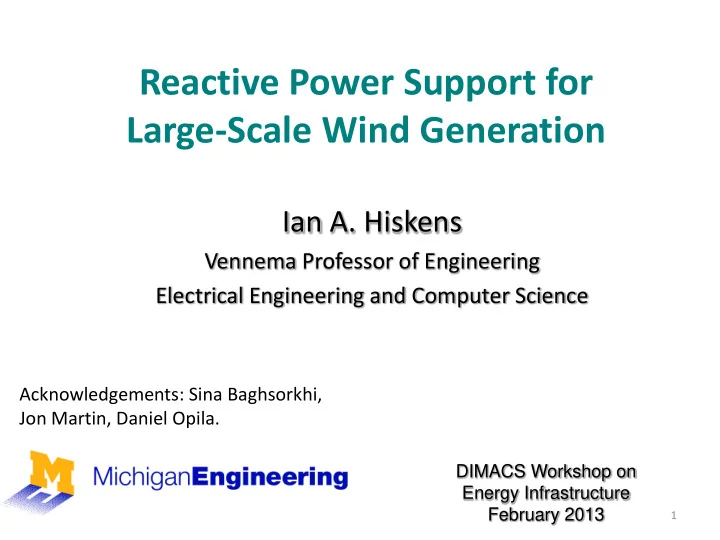

Reactive Power Support for Large-Scale Wind Generation Ian A. Hiskens Vennema Professor of Engineering Electrical Engineering and Computer Science Acknowledgements: Sina Baghsorkhi, Jon Martin, Daniel Opila. DIMACS Workshop on Energy Infrastructure February 2013 1
Motivation (1) • Utility-scale wind generation should be capable of: – Voltage regulation. – Dynamic reactive support. • Provision of these services should be consistent with traditional generation. • Wind-farms are composed of many distributed wind turbine generators (WTGs). – Behavior is vastly different to a single large generator. 2
Motivation (2) • A number of issues have been observed in practice: – Many wind-farms are located at lower (sub-transmission) voltage levels. – Actual reactive power available from wind-farms is less than predicted. – Ad hoc schemes are used to coordinate capacitor/reactor switching with Statcom/SVC controls. • Excessive switching, resulting in high circuit-breaker maintenance. • Reduced dynamic (fast acting) reactive reserve. 3
Outline • Wind-farms on sub-transmission networks. • Reactive power from the collector system. • Coordination of wind-farm reactive sources. 4
Wind-farm overview Collector network 5
Wind-farms at sub-transmission 6
Effect of resistance • Voltage contours for a two- node network: R=0.0pu, X=0.5pu R=0.5pu, X=0.5pu 7
With resistance No resistance Resistive line 8
Wind-farm voltage control • Constant power factor/ limited voltage control: – Increased tap operations at distribution OLTCs. – Reduced tap operations at sub-transmission OLTCs. • Full voltage control: Reduced tap operations at – distribution OLTCs. – Increased tap operations at sub-transmission OLTCs. 9
Reactive power availability • Generator voltage limits restrict maximum available reactive power. 10
11
Farm-level system optimization 12
Information classes 1) Exact Future Knowledge - Exact knowledge of the future for the full time horizon. 2) Stationary Stochastic Knowledge- Stationary stochastic predictions about the future, no explicit forecasting. 3) No Explicit Future Knowledge- Both optimization- and rule-based methods. 13
Controllers with future knowledge STATCOM Usage Number of Capacitor Switches Given Data Objective 1) Exact future knowledge: P(t) Deterministic Dynamic Programming (DDP) 2) Stochastic knowledge: P(P k+1 | P k ) Stochastic Dynamic Programming (SDP) 15
Controllers without future knowledge Given Data Control Law 3a) No future knowledge: None Instantaneous optimization Threshold STATCOM Usage 3b) No future knowledge: None Rule-based hysteresis 16 Number of Capacitors
Capacitor switching versus Statcom 17
18
Exact future knowledge Stochastic future knowledge 19
Conclusions • Resistance can have an important, but non- intuitive, effect for wind-farms connected at the sub-transmission level. • Total reactive power available from WTGs may be much less than expected. • System-level control of substation equipment can improve performance, but future information is important. 20
Recommend
More recommend